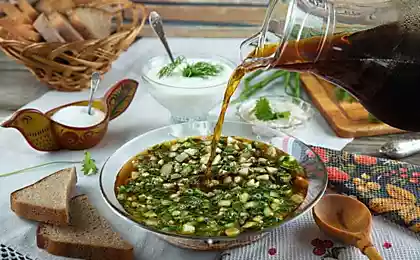1327
Interesting facts about kvass
In the heat there is nothing better than a cold drink, vigorous kvas. Offer remember interesting facts from the history of traditional Russian drink.

People's love
Perhaps no one drink in Russia has such a rich history. Eastern Slavs prepared him well before the Baptism of Russia, and the first official confirmation of the popular veneration of kvass can be found in the annals of 996 years: Christian converts by decree of Vladimir Svyatoslavovich treated "food, honey and kvass." Vigorous and invigorating drink loved by all, without exception, young and old, regardless of rank and title. They were treated in a royal mansion and the monastery walls in peasant huts and soldiers' barracks, at fairs and in the grand salons. It is known that kvass certainly included rations of prisoners. According to statistics, every citizen annually consumed 250 liters of kvass.
The result is worth it!
By the beginning of the XV century there were more than 500 varieties of the national drink: sweet and sour, mint and raisins, thick and brew-soup, sweet and diurnal, white and okroshechny with horseradish (Ural) and Boyarsky, aromatic and wheat, pepper and pear . By the way, at the end of the XIX century it brew of boiled pears leader among beverages residents throned. The traditional recipe of kvass quite laborious: soak and sprout corn, steamed, grind, cook the wort. Wait for the results accounted for more than two months, but it was worth it!
King wants trapeznichat
Democratic drink was at a premium at the Russian tsars. It is known that the "brew in a silver loschatoy Bratina" Alexei Mikhailovich was served at a festive wedding feast. Peter loved utretsa to try kvas with horseradish - invigorating drink prepared by our own recipe reformer. I do not refuse to drink kvas and Anna Ivanovna. Empress and her guests filed drink, grimacing, Prince Mikhail Golitsyn, demoted for apostasy in court "fools" -shuty. Grigory Potemkin - another supporter of traditional Russian cuisine. Leavened cabbage invariably accompanied by His Serene Highness Prince in military campaigns in distant wanderings, and "for the sake fermentation pleasant 'he personally, a day ready to drop down into the beverage flavor.
Charm
"If I had bread and kvas - so all we have", - loved to sentence in the old days. Kvass is often a mandatory attribute of many ceremonies. So, for the bride to prichetami and songs prepared bath, certainly not forgetting the "leavened spirit": drink splashed on the stove, and the remainder - finishing their. After the wedding, the young have traditionally met the caravan and kvas. It was believed that to win the fire, which is the result of a lightning strike can only be filling his kvass (or milk), and to stop the flames will certainly need to throw a hoop that was used for the preparation of kvass in a wooden gang.
Again nakvasilsya?
Fortress kvass, which was prepared by our ancestors, was not quite so harmless: the alcohol content could reach 15%. Those who are overly fond of tasting beer, called "kvass". The verb "to booze" successfully survived to the present day, with the semantics of it absolutely has not changed.
Kvasnikov
The popularity of kvass identified and the emergence of a respected profession. Kvasnikov not only prepared an invigorating drink, but also to realize the product. At the end of the XIX century the most popular place in Moscow, where in summer you can enjoy a kvass was Okhotny Ryad: up to thousands of merchants offering the public "cold kvas-a-ha." In other cities, each "holding" their district, without giving outsiders and turn to competitors. Wanting to stand out among his colleagues, kvass inventing more and more new varieties, surprising the original consumer tastes. Dreamed probably create the perfect drink, which would speak far outside their hometown, so they prefer to specialize in any one species of kvass again and again improving the original recipe.
Typically, beverage ingredients and specialty Kvasnikov determined: there is a "fine-ground," and he won - "pear". Browse Kvasnikov was easy and on the streets of St. Petersburg: they carried a glass bowl with kvass and head covered with a headdress resembling a cylinder. Confidence that kvass has miraculous powers, allows not worrying too much about hygiene: everyone enjoyed kvas drink from the same glass.
ATSPT and «Coca-cola»
In the 30s of last century the streets of Moscow could see the booth-carts, and next to them - sullen traders in aprons are not the first freshness. A glass of "Bavarian kvass" in those days was worth 20 kopecks (for comparison: a scholarship student averaged 130 rubles). A little later came the so-called "yellow barrels," which in official documents called "food insulated tanker" or ATSPT. Kvass is released in cans. The most impatient could quench their thirst on the spot by purchasing a small or a large mug of kvass. Interestingly, on the design of reusable glass mugs into which he poured brew bother the author of the legendary "Worker and Collective Farm" Vera Mukhina. Despite the fact that today's market offers a huge number of kvass, many still prefer the "kvas from the barrel" or beverage prepared at home recipe.
The traditional Russian drink gained recognition not only at home. In 1975 at the International Competition held in Yugoslavia, excellent taste "Moscow kvass" appreciated and jury members and guests of the event. As a result, "Mighty" and "tickling" Russian drink scored 18 points, while the «Coca-cola», which, incidentally, will appear in Russia only in 1988 - failed to earn and 10.

People's love
Perhaps no one drink in Russia has such a rich history. Eastern Slavs prepared him well before the Baptism of Russia, and the first official confirmation of the popular veneration of kvass can be found in the annals of 996 years: Christian converts by decree of Vladimir Svyatoslavovich treated "food, honey and kvass." Vigorous and invigorating drink loved by all, without exception, young and old, regardless of rank and title. They were treated in a royal mansion and the monastery walls in peasant huts and soldiers' barracks, at fairs and in the grand salons. It is known that kvass certainly included rations of prisoners. According to statistics, every citizen annually consumed 250 liters of kvass.
The result is worth it!
By the beginning of the XV century there were more than 500 varieties of the national drink: sweet and sour, mint and raisins, thick and brew-soup, sweet and diurnal, white and okroshechny with horseradish (Ural) and Boyarsky, aromatic and wheat, pepper and pear . By the way, at the end of the XIX century it brew of boiled pears leader among beverages residents throned. The traditional recipe of kvass quite laborious: soak and sprout corn, steamed, grind, cook the wort. Wait for the results accounted for more than two months, but it was worth it!
King wants trapeznichat
Democratic drink was at a premium at the Russian tsars. It is known that the "brew in a silver loschatoy Bratina" Alexei Mikhailovich was served at a festive wedding feast. Peter loved utretsa to try kvas with horseradish - invigorating drink prepared by our own recipe reformer. I do not refuse to drink kvas and Anna Ivanovna. Empress and her guests filed drink, grimacing, Prince Mikhail Golitsyn, demoted for apostasy in court "fools" -shuty. Grigory Potemkin - another supporter of traditional Russian cuisine. Leavened cabbage invariably accompanied by His Serene Highness Prince in military campaigns in distant wanderings, and "for the sake fermentation pleasant 'he personally, a day ready to drop down into the beverage flavor.
Charm
"If I had bread and kvas - so all we have", - loved to sentence in the old days. Kvass is often a mandatory attribute of many ceremonies. So, for the bride to prichetami and songs prepared bath, certainly not forgetting the "leavened spirit": drink splashed on the stove, and the remainder - finishing their. After the wedding, the young have traditionally met the caravan and kvas. It was believed that to win the fire, which is the result of a lightning strike can only be filling his kvass (or milk), and to stop the flames will certainly need to throw a hoop that was used for the preparation of kvass in a wooden gang.
Again nakvasilsya?
Fortress kvass, which was prepared by our ancestors, was not quite so harmless: the alcohol content could reach 15%. Those who are overly fond of tasting beer, called "kvass". The verb "to booze" successfully survived to the present day, with the semantics of it absolutely has not changed.
Kvasnikov
The popularity of kvass identified and the emergence of a respected profession. Kvasnikov not only prepared an invigorating drink, but also to realize the product. At the end of the XIX century the most popular place in Moscow, where in summer you can enjoy a kvass was Okhotny Ryad: up to thousands of merchants offering the public "cold kvas-a-ha." In other cities, each "holding" their district, without giving outsiders and turn to competitors. Wanting to stand out among his colleagues, kvass inventing more and more new varieties, surprising the original consumer tastes. Dreamed probably create the perfect drink, which would speak far outside their hometown, so they prefer to specialize in any one species of kvass again and again improving the original recipe.
Typically, beverage ingredients and specialty Kvasnikov determined: there is a "fine-ground," and he won - "pear". Browse Kvasnikov was easy and on the streets of St. Petersburg: they carried a glass bowl with kvass and head covered with a headdress resembling a cylinder. Confidence that kvass has miraculous powers, allows not worrying too much about hygiene: everyone enjoyed kvas drink from the same glass.
ATSPT and «Coca-cola»
In the 30s of last century the streets of Moscow could see the booth-carts, and next to them - sullen traders in aprons are not the first freshness. A glass of "Bavarian kvass" in those days was worth 20 kopecks (for comparison: a scholarship student averaged 130 rubles). A little later came the so-called "yellow barrels," which in official documents called "food insulated tanker" or ATSPT. Kvass is released in cans. The most impatient could quench their thirst on the spot by purchasing a small or a large mug of kvass. Interestingly, on the design of reusable glass mugs into which he poured brew bother the author of the legendary "Worker and Collective Farm" Vera Mukhina. Despite the fact that today's market offers a huge number of kvass, many still prefer the "kvas from the barrel" or beverage prepared at home recipe.
The traditional Russian drink gained recognition not only at home. In 1975 at the International Competition held in Yugoslavia, excellent taste "Moscow kvass" appreciated and jury members and guests of the event. As a result, "Mighty" and "tickling" Russian drink scored 18 points, while the «Coca-cola», which, incidentally, will appear in Russia only in 1988 - failed to earn and 10.























